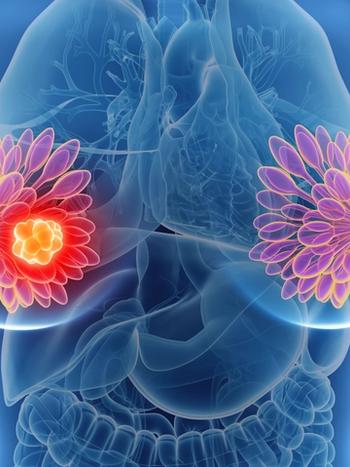
Oncology NEWS International
- Oncology NEWS International Vol 8 No 2
- Volume 8
- Issue 2
Doxorubicin Appears to Change Natural History of HER-2+ Cancer’s
PITTSBURGH-Two different National Surgical Adjuvant Breast and Bowel Project (NSABP) trials have provided evidence that doxorubicin “somehow changes the natural history” of breast cancer in patients whose tumors overexpress the HER-2 cancer gene, Soon Paik, MD, said at the San Antonio Breast Cancer Symposium.
PITTSBURGHTwo different National Surgical Adjuvant Breast and Bowel Project (NSABP) trials have provided evidence that doxorubicin somehow changes the natural history of breast cancer in patients whose tumors overexpress the HER-2 cancer gene, Soon Paik, MD, said at the San Antonio Breast Cancer Symposium.
The most recent data came from NSABP B-15, which compared the combination of doxorubicin (Adriamycin) and cyclophosphamide (AC) (alone or followed by CMF) against CMF (cyclophosphamide, methotrexate, fluorouracil). The findings essentially confirmed data from the earlier B-11 trial, which evaluated the effect of adding doxorubicin to an older breast cancer chemotherapy regimen in patients with node-positive, ER-negative disease (J Natl Cancer Inst 90:1361-1370, 1998).
The overall results of B-15 showed no outcome differences among the three regimens, said Dr. Paik, a pathologist at Allegheny University of the Health Sciences, Pittsburgh, and director of the NSABP Pathology Section. However, an analysis of the 29% of patients who overexpressed HER-2 revealed a clear trend favoring the doxorubicin-containing regimen with respect to disease-free and overall survival.
The B-15 study involved 2,295 patients, 2,034 of whom were included in the analysis. The study population comprised 689 patients randomized to the AC regimen, 679 randomized to AC followed by CMF, and 666 randomized to CMF. Dr. Paik said that 599 patients were positive for HER-2.
HER-2-positive patients treated with CMF had a relative risk of 1.24 for disease-free survival, compared with 0.99 for the AC cohort. For overall survival, CMF patients had a relative risk of 1.45 vs 1.05 for patients treated with the AC regimen. A similar pattern was observed in patients who received AC followed by CMF, Dr. Paik said. Their relative risk for disease-free survival was 1.12 and for overall survival, 1.04.
In patients treated with AC or AC followed by CMF, overexpression of HER-2 was prognostic with a relative risk near 1, which tells us that the addition of Adriamycin somehow changes the natural history of patients who are HER-2 positive, Dr. Paik said. There was no difference in relative risk for HER-2-negative patients. The reduction in risk was seen only in HER-2-positive patients. We observed the same pattern of benefit whether we included or excluded second primary cancers or contralateral breast cancers.
Confirms B-11 Results
The B-15 data confirm an analysis of B-11, which randomized patients to the combination of L-phenylalanine mustard (melphalan) and fluorouracil, with or without doxorubicin (PF or PAF). Of 638 evaluable cases (ie, those with archived stained sections of the primary tumor), 239 were positive for HER-2 overexpression.
HER-2-positive patients randomized to the doxorubicin-containing regimen (PAF) had a relative risk of 0.58 for recurrence-free survival, 0.74 for disease-free survival, and 0.66 for overall survival, compared with patients in the PF cohort. In contrast, HER-2-negative patients treated with PAF had no advantage over PF patients, as the relative risk approached 1.00 for all outcome parameters.
The B-15 data are consistent with those from B-11, Dr. Paik said. Because of the consistencies, I think the B-15 data can be regarded as a confirmation of B-11. I personally conclude that AC can be used safely in HER-2-positive patients and does not add harm over CMF when given to HER-2-negative patients.
A preliminary analysis of data from NSABP B-14, which evaluated the effect of tamoxifen (Nolvadex) on survival parameters, has demonstrated that HER-2 status does not predict outcome with tamoxifen, Dr. Paik added.
Articles in this issue
almost 27 years ago
Paclitaxel Plus Mitoxantrone for Poor-Prognosis Breast Canceralmost 27 years ago
Faslodex, Pure Antiestrogen, Studied in Tamoxifen-Resistant Breast Canceralmost 27 years ago
LHRH Agonist Plus Tamoxifen Improves Outcome in Young Metastatic Patientsalmost 27 years ago
Pros and Cons of Different Approaches to Chemoradiationalmost 27 years ago
Less Cardiotoxicity With Liposomal Doxorubicinalmost 27 years ago
Optimizing Docetaxel Tolerability in Anthracycline-Resistant Breast Canceralmost 27 years ago
Tamoxifen After Surgery/RT Decreases Local Recurrence Risk in DCIS Patientsalmost 27 years ago
Dose-Intensive Chemo Improves Disease-Free Survival in High-Risk CancerNewsletter
Stay up to date on recent advances in the multidisciplinary approach to cancer.

























































































